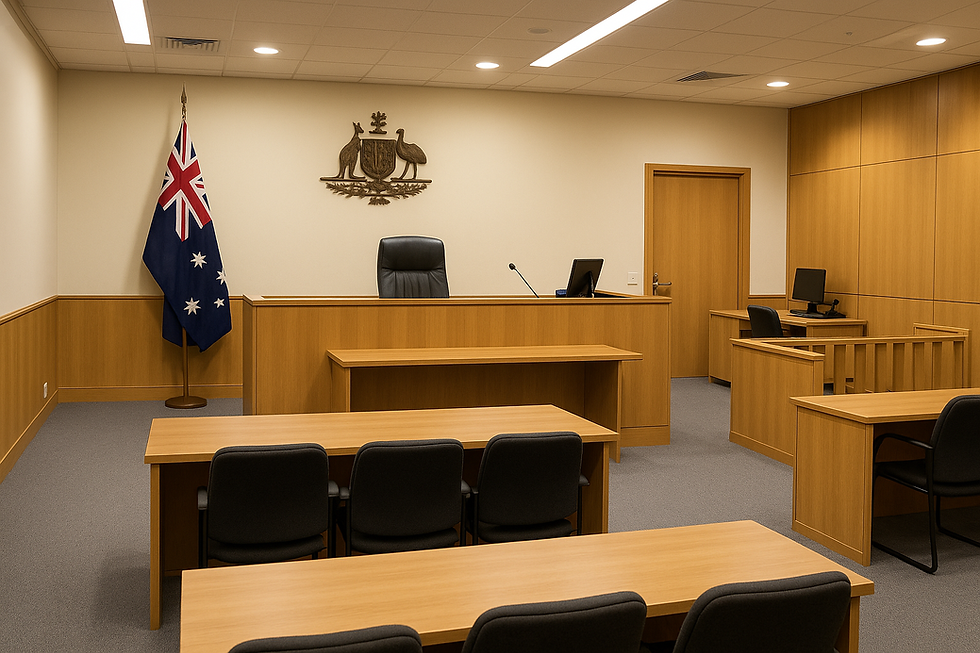How to Defend a Criminal Charge
- Jarrod Carter
- Nov 9, 2022
- 5 min read

When a criminal matter goes to trial, there are two possible paths to a verdict of not-guilty. The first is putting the prosecution to proof, and disputing an element of the offence. The second is to prove the necessary elements of a legally recognised defence.
Disputing an Element
Each criminal offence has certain elements that need to be individually proved beyond a reasonable doubt before the court, or a jury, can render a verdict of guilty. Unless each element is proved, the accused retains their presumption of not-guilty.
We can determine the elements of an offence by reading its definition in the criminal code. Assault is defined as:
A person who strikes, touches, or moves, or otherwise applies force of any kind to the person of another, either directly or indirectly, without his consent, or with his consent if the consent is obtained by fraud, or who by any bodily act or gesture attempts or threatens to apply force of any kind to the person of another without his consent, under such circumstances that the person making the attempt or threat has actually or apparently a present ability to effect his purpose, is said to assault that other person, and the act is called an assault.
The term “applies force” includes the case of applying heat, light, electrical force, gas, odour, or any other substance or thing whatever if applied in such a degree as to cause injury or personal discomfort.
From this definition we can see that the elements of the offence that need to be proved include:
The accused’s identity
The victim’s identity
The application of force OR real threat to apply force
The absence of legitimate consent
Counsel for the accused may cross-examine the victim on the element of the accused’s identity. They may question the victim’s recount of the event. For example, if the perpetrator was wearing a face mask at the time, there may be a reasonable doubt that the accused person actually committed the assault. This may require nothing more than having the victim admit under cross examination that the person who assaulted them was wearing a mask. The victim may hold the mistaken belief as to the identity of the perpetrator because the accused person has a similar build and body shape.
Similarly, counsel may cross-examine the victim on the application of force. If a victim was struck by an item that came from a balcony, it may be difficult to prove beyond a reasonable doubt as to whether the item fell, or was maliciously thrown. If it is reasonably likely that the wind blew the item off the balcony (which struck the victim), then it cannot be established that anyone applied force to cause injury from the item.
In order to find someone guilty of a crime, the prosecution must establish each element of the offence beyond a reasonable doubt. If an element is only established on shaky ground, that may provide enough doubt as to cause a finding of not guilty. It is important to note that because of the presumption of innocence, the accused is not required to prove that they didn’t commit the offence. The burden of proof is upon the prosecution to prove that they did.
Running a Defence
Criminal defences are different from challenging an element of an offence because they essentially accept that all of the elements of the offence are proved. However, the accused denies the commission of the offence. They claim that their actions are justified due to a legally recognised defence.
Some of the defences to Assault include:
Provocation
Self-defence OR defence of another
Accident
Extraordinary Emergency
Mistake of Face
An example of a defence that would not be legally recognised would be a case where a person commits an assault and their justification was not protected by a defence. An example would be the abhorrent practice of throwing acid in the faces of women. In 2019 in India, 300 cases were reported. The justification for such ruthless acts are often as insignificant as a woman simply rejecting a man’s romantic advances. For good reason, feeling rejected is not a legally recognised defence.
In assault cases, the most common legally recognised defence is self-defence. This means that the accused admits that they applied force to the victim without their consent so the elements are proved. However, they also say that they were required to apply the force in order to protect themselves, (or someone else) as they were under attack, or reasonably believed the attack was imminent.
Under Section 248 of the Criminal Code Act Compilation Act 1913, A person’s harmful act is done in self-defence if —
(a) the person believes the act is necessary to defend the person or another person from a harmful act, including a harmful act that is not imminent; and
(b) the person’s harmful act is a reasonable response by the person in the circumstances as the person believes them to be; and
(c) there are reasonable grounds for those beliefs.
An accused bears the evidential onus of adducing or pointing to prosecution evidence, on which a jury (or a court of summary jurisdiction) acting reasonably might fail to be satisfied beyond reasonable doubt that the accused was not acting in self defence. So essentially, once the elements of the offence are proved, the only way the accused can be found not guilty is if they can provide, or point to, evidence which establishes the elements of a defence.
In Goodwyn v The State of Western Australia, Justice Buss JA explained the elements and evidential burden raised in s 248(4) as follows:[12]
So, it is apparent that s 248(4) enumerates four elements. First, the accused (subjectively) believes the harmful act is necessary to defend the accused or another person from a harmful act, including a harmful act that is not imminent (s 248(4)(a)). Secondly, the accused's harmful act is a reasonable (objective) response by the accused in the circumstances as the accused (subjectively) believes them to be (s 248(4)(b)). Thirdly, there are reasonable (objective) grounds for the accused's (subjective) belief that the harmful act is necessary to defend the accused or another person from a harmful act, including a harmful act that is not imminent (s 248(4)(a) read with s 248(4)(c)). Fourthly, there are reasonable (objective) grounds for the accused's (subjective) belief as to the circumstances (s 248(4)(b) read with s 248(4)(c)).
If the accused satisfies the evidential onus in relation to self defence then the burden is on the State to negative the defence by excluding at least one of its elements beyond reasonable doubt.
While this is complicated, it essentially means that if an accused provides the necessary evidence to establish the four elements of self-defence, the prosecution must “negative the defence” by providing evidence to refute at least one of the elements of the defence.
For example, the prosecution could provide CCTV footage of the victim looking at their phone with their back to the accused immediately prior to the assault. This evidence would effectively negate the evidence of the accused’s belief that they were required to commit a harmful act to defend from a harmful act. It is likely that such evidence would establish that the victim was not a threat and that the assault was unlawful.
There are various other defences and each of them function in the same way. If an accused provides the necessary evidence to establish the elements of the defence, the prosecution must “negative the defence” by providing evidence to refute at least one of the elements of the defence.
Criminal charges and defences are often more complex than they appear. If you have been charged with a criminal offence, it is always a good idea to speak with an experienced lawyer to obtain advice on how to proceed. This could include pleading guilty, or even negotiating with the police (or State) to drop or reduce the charges. If you didn’t commit the act, then you may wish to fight the charges by disputing the elements of the offence. Conversely, you may wish to run a defence.




Comments